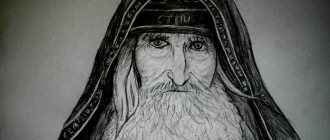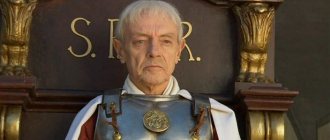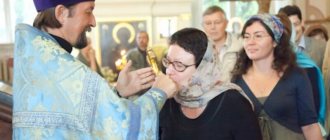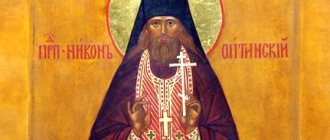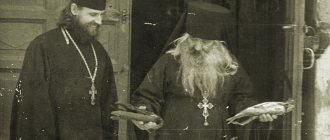The Church of Christ has retained its original appearance for several thousand years. That is, the basic sacraments and teachings have not changed since the time of Christ himself and his apostles. It is worth noting that the Church is a living organism, and it consists of ordinary people. It is Orthodox people who sacredly protect the canons and traditions of the Church. Thus, the church hierarchy established by the apostles themselves has been preserved to this day. We will talk about the second level of the clergy, namely the priest, or archpriest.
Origin and etymology
The term "hieromonk" is a Greek construction that comes from two roots - "hieros" and "monos". The first of them is translated as “sacred”, and the second – “one”. Therefore, this word literally translates as “sacred loner.” However, “monos” is also a special, so to speak, technical term that means a hermit who has chosen the path of religious perfection outside the bonds of marriage and attachments to the world. Therefore, this word entered the Russian language without translation in the form “monk”. As for “hieros,” the word “hiereus” comes from it, that is, “priest.” In this refraction, a hieromonk is simply a priest-monk. It is in this meaning that this word is used in Orthodoxy and in Christianity in general.
Archpriest in the church hierarchy
In the Orthodox Church there are three levels of hierarchy of clergy. A representative of each level has different responsibilities both during service and in Church life.
The priest at the head of the parish community is called the rector
Deacons belong to the first and lowest level. These clergy assist the priest or bishop in performing divine services. Their voices serve as a kind of decoration during the service: the main purpose of the deacon is to beautifully proclaim prayers and sing. However, the deacon does not have the grace to perform the seven church sacraments. Therefore, he has no right to celebrate the Liturgy alone.
Read about the Orthodox Church:
- Why and for what does the Church collect money?
- Who is a vicar
- Colors and symbolism of the domes in the temple
At the second level of clergy are priests. These are people who can perform the six sacraments. In the Orthodox Church they are called priests or archpriests. From the Greek, the word “priest” is translated as priest.
Attention! Archpriests are those priests who have served Christ and His Church impeccably for many years. This is a kind of reward for work, which gives slight advantages over ordinary priests.
As mentioned earlier, in the Russian Orthodox Church the task of the priest is to perform divine services, anointing, baptism, unction, wedding, confession and communion. What distinguishes a priest from a deacon is his vestment. Priests put on a phelonion or chasuble, and an epitrachelion (a long ribbon that goes around the neck). Outside of services, the priest may wear a cassock or cassock (a long, dark robe with narrow or wide sleeves) with a pectoral cross on top. Outside the temple, the priest may wear ordinary clothes.
Read about the Sacraments performed by the priest:
- Confirmation
- Participle
- Confession
The last and highest level is bishopric. Bishops can ordain others as deacons and priests. In the Orthodox Church, only monks can become bishops.
Important! After ordination (consecration) as a deacon, a clergyman does not have the right to marry. Otherwise, such a person will be prohibited from serving and will be defrocked.
Story
It is known that initially monks could not take holy orders. This was due to the fact that they lived a hermit life and could not engage in pastoral and social activities, which were associated with the ministry of a priest. Therefore, for the first centuries of Christianity, a hieromonk was something unthinkable and contradictory. However, later, when the monks began to unite and form their own communities, which grew into monasteries, they began to need both their leaders and their priests. Therefore, some of them began to be elected and presented for ordination. This is how the first hermit priests appeared. The hieromonk's preaching was limited to the monastery brethren and the occasional pilgrims who came to them. The ancient monasteries were located in deserted, deserted places, and therefore lay people appeared there infrequently. However, already in the early Middle Ages, monasteries increasingly began to appear in the suburbs and even inside the cities themselves. Most often they were founded by ruling figures - monarchs, barons and other aristocrats. The life of a hieromonk in such a monastery, unlike his brothers on the periphery of civilization, was connected with politics no less, and sometimes more, than with priestly and spiritual service. In the modern world, monastics no longer hide from the world as before, and therefore many monasteries are located within the city limits. In addition, if previously only selected brothers from among the inhabitants of the monastery were awarded the priesthood, today in monasteries almost 100% of the monks are priests. There are, of course, exceptions to this rule, but this is the trend.
Hieromonk Matyushin
Among the most famous hieromonks of our days, one can name Photius Mochalov, winner of the second season of the television competition “The Voice” and Hieromonk Roman.
The songs of Hieromonk Roman are familiar to many admirers of Orthodox poetry. Alexander Ivanovich Matyushin-Pravdin (father Roman had this name before he was tonsured) was born in 1954 in the Bryansk region. He studied at the philology department of Kalm State University, but did not receive a diploma because he refused to take state exams. He taught music lessons at school, was also engaged in carpentry, and at one time was a worker at a silicate plant. Already in his youth, Alexander realized that his life’s calling was to become a hieromonk, this is reflected in his early poems.
In the early eighties of the twentieth century, a young man decided to fulfill his dream. So he ended up in a monastery in the city of Vilnius, and then in the Pskov-Pechersky Monastery, where he was tonsured a monk with the name Roman. Four years later he was ordained hieromonk. Father Roman's mother, who worked as a teacher in a rural school, also became a nun. All these years, Hieromonk Roman continued to write poetry. At first, he did not write songs during his monastic life, but after a conversation with an old priest, he reconsidered his attitude towards music. In his own words, the priest told him that the guitar, unlike other musical instruments, is an instrument with which you can pray.
Hierarchy within religious priests
We found out that a hieromonk is a priest who has taken monastic vows. But the official title of such a clergyman may change over time. For example, there is the rank of abbot. Previously, only abbots of monasteries were called abbots. In other words, these were hieromonks who were given, in addition to the priestly power, the supreme administrative power in the monastery. A similar position, but more honorable and higher in the hierarchy, is archimandrite. In the Orthodox tradition, bishops are chosen from among the archimandrites. Even a hieromonk elected to the episcopal see accepts the rank of bishop only after first receiving the rank of archimandrite. Sometimes such archimandrites hold their title for no more than a day. At present, both abbess and archimandrite are, as a rule, not administrative positions, but honorary award titles. Such priests are really no different from ordinary hieromonks, with the exception of more luxurious vestments and some authority among believers.
Literary and monastic work of Hieromonk Roman
Since the mid-nineties, Father Roman has been carrying out his monastic feat at the Vetrovo monastery in the Pskov region, where in the 2000s he closed himself off from the world for some time and kept in touch with other monks only through notes.
At the moment, more than twenty collections of poems by Hieromonk Roman Matyushin have been published, as well as more than ten albums with the author’s songs.
Father Roman's songs are performed by such famous artists as Maxim Troshin, Irina Skorik, and the Kuban Cossack Choir.
Zhanna Bichevskaya, Sergei Bezrukov and Oleg Pogudin recorded albums of songs written by Hieromonk Roman. Bezrukov recalls that during the recording of the album, studio workers came to the monastery of Father Roman, but they were not able to communicate with him, since at that time he was fulfilling a vow of silence. It was possible to obtain written permission to use his works. The hieromonk himself believes that copyrights should not exist, since poems and songs are given to man by the Lord.
Hieromonks in other faiths
Orthodoxy is not the only Christian denomination where there are monastic priests. These are also found in Catholicism and Anglicanism. In addition, there are a number of churches that associate themselves with Orthodoxy, but historically go back to the Monophysite and Nestorian communities. Being very ancient, they also preserve the monastic tradition and, accordingly, have priests from monks. They are called differently, however, everywhere. The Greek term “hieromonk” itself is the property of only Orthodox churches of the Byzantine tradition, which includes the Russian Orthodox Church MP. In addition, this word is used among Greek Catholics, that is, Catholics who adhere to the Eastern Orthodox rite.
How to become a priest
Many, following the call of their hearts, strive for the Lord. Some see themselves as an ordinary parishioner, while others see themselves as a priest or even a monk.
Ordination to the rank of archpriest
In order to become a priest, you need to go a long way. You can forget about the career ladder, which is usually observed in worldly life.
- First of all, a candidate for priesthood must overcome temptations and himself, that is, he must grow spiritually. The main requirement for such a person is to be baptized in the canonical Orthodox Church. Such a believer must attend services and serve at the temple so that the rector of this temple can write a description and issue a referral.
- Already with the direction, this believer enters a higher theological educational institution, simply a seminary. To enter the seminary, you must have a complete secondary or higher education.
- Depending on the desire and recommendation of the spiritual father, a person can be ordained either in the first years of study or after graduating from the seminary. First, the ordination to the deacon takes place.
Important! This is the first step of the priesthood and there is no way to miss it. And only forty days later the ordination to the priesthood takes place.
From conversations with Roman Matyushin
In his few interviews, the hieromonk talks about some important issues for a believer. Father Roman considers life in nature useful for the spiritual development of a person, although he says that the main thing is not the place, but faith in the Lord and sincere prayer.
About the power of folk art, Father Roman says that he himself experienced this power when a folk song sung by Nikolai Guryanov (priest, author of spiritual songs and poems, in particular, his songs are heard in the film “Island” performed by Pyotr Mamonov) strengthened him in his decision become a monk.
He also talks about the uselessness of “lite” Orthodoxy, which is often perceived by many people as true. Lightweight - that is, one that is based only on the external performance of rituals, without faith in God.
